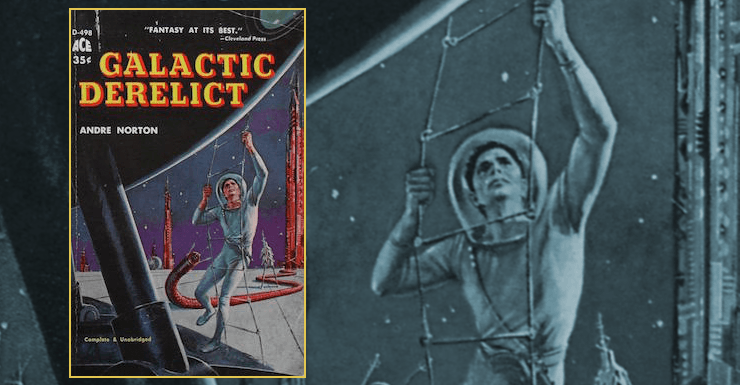Galactic Derelict is another Andre Norton novel I almost-remember reading. I remember the opening, with a Norton Hero(TM) riding into a camp in the desert. I very vaguely remember that this iteration was Native American—Apache, he turns out to be.
I had forgotten that Travis Fox is in Arizona, and I wouldn’t have known that I’d end up living not all that far away from where his ranch is supposed to be, along with the secret Canyon of the Hohokam where he meets a crew of time travelers masquerading as archaeologists. That turned out to be a nice bonus. I know the landscape, and I can imagine going for a horseback ride in the desert and running across a dig. Archaeological sites are rather thick on the ground out here. There are Hohokam villages everywhere.
Unlike the previous volume in the series, Time Traders, this one doesn’t spend much time in the prehistoric era, and there’s not much human contact to speak of. Almost as soon as Travis stumbles across the camp, he learns what it really is, and he has to make a choice: be put “on ice” back at headquarters (though whether that’s literal, as in cryo-storage, or figurative, as in indefinite detention, isn’t quite clear) or join the team.
This isn’t as difficult to credit as it might seem. Travis is a trained archaeologist. He has a distinct leg up over Ross Murdock when he first signed on, which is good, because Travis doesn’t get anything like the months of training Ross had. He’s thrown right into an expedition to the Folsom period, twelve thousand years ago, and a hunt for one of the numerous wrecked alien spaceships that dotted the earth at that time.
They find what they’re looking for, and then some. Not only is the ship where they thought it was—it’s still functional. A crew of techs immediately converges on it and sets it up to be moved to the present day, where it can be studied in peace; the presumption is that the galactic empire or whatever it was has fallen in the interim and no one will come looking for the lost ship.
The project is urgent, because the area the ship is in is highly volcanically active. In fact, just as the time portal is ready, one of the nearest volcanoes blows. And then a herd of mammoths stampede straight toward the ship.
It just so happens that four people manage to take refuge in the ship when it all goes splooie: Travis, Ross, Ross’ partner/mentor Ashe (whom Travis recognized at first meeting as a well-known archaeologist), and a tech named Renfry who’s been checking out the ship’s controls. In the confusion of the portal’s being activated, the ship powers up and begins a launch sequence that’s fully automatic and cannot be stopped.
Luckily the ship has reached the present day before it launches, which means the passengers are probably safe from alien patrols. But they have no idea where they’re headed or how long it will take or even if they can survive on the ship.
While they’re in transit, Travis takes it on himself to experiment with the food stores and determine which are edible or drinkable and which are painfully not. It’s still very lean rations that have to stretch over an unknown span of time. Meanwhile they don’t dare mess with the controls, at all, though Renfry does what he can to figure out the navigation tape, and they have no idea what to plan for or expect.
What they get is a landing on a deserted world where the spaceport still sort of functions, where the ship takes on fuel and departs in fairly short order; then another world around a different sun, where the passengers run afoul of a favorite Norton trope: vile, hostile alien monsters. They just barely get out ahead of those, for another, much shorter hop within in the same system. And that, apparently, is the ship’s home base. It’s alive, green, and full of various forms of life, mostly benevolent and a few emphatically not.
One of the former is a species of intelligent beings with some memory of the fallen empire, who are willing to trade with the humans for what the humans hope will be navigation tapes like the one Renfry has been figuring out. All they want to do, in true Dorothy-in-Oz fashion, is find a way to get home. Renfry hopes he can reverse the tape that brought him here, but it’s a wild gamble.
It does, in the end, pay off, and we’re set up for the next installment, The Defiant Agents. Meanwhile the project has a viable starship and a decent start on how to run it, and a fair certainty that empire it comes from is long gone.
Travis Fox is an interesting character, and not just because he’s Native American in a novel first published in 1959. He’s an obvious cousin to Hosteen Storm of the Beast Master series, and Kade Whitehawk, the “Sioux Spaceman.”
Norton tried hard to give voices to non-whites and especially Native Americans. Travis is an Apache, and while there’s more than a hint of the racial determinism that Norton didn’t seem able to avoid despite her best intentions, he’s explicitly not stereotyped as poorly educated and poverty-stricken. He declares firmly, “I did four years at State U. There’s more to us than beads and feathers.” For a boy’s adventure published in 1959, this is just a little bit radical.
Buy the Book


The Consuming Fire
Travis and Ross butt heads fairly often especially in the beginning, and that’s subversive, too. Ross is white, but he came to the project with minimal education, and he has a criminal record. Travis is the one with the college degree and the academic expertise—but he’s also been shut out of a job in his field by plain old ugly racism.
Norton makes sure we know exactly what happened and who did it and why, and shows us how justifiably angry Travis is, but also how powerless he was to stop it. Then she gives him a dream job and a trip into space—and some solid prehistoric adventures, too, including encounters with sabertooth cats, giant ground sloths, and mammoths.
We don’t get much interaction with prehistoric human cultures this time, but the alien contacts easily make up for it. They’re all postapocalyptic remnants, and some appear to have devolved from their original intelligence and culture.
The humans do their best to figure out them all out. The process of learning to survive on an alien ship without an instruction manual, and then on alien worlds for which there is no possible preparation, is a good part of the fun.
I’ll be interested to see what happens now humans (of all ethnicities) have access to space as well as time travel. The Defiant Agents will do at least some of that (with some…problematical elements, but we’ll get to those next time).
Judith Tarr’s first novel, The Isle of Glass, appeared in 1985. Her most recent novel, Dragons in the Earth, a contemporary fantasy set in Arizona, was published by Book View Cafe. In between, she’s written historicals and historical fantasies and epic fantasies and space operas, some of which have been published as ebooks from Book View Café. She has won the Crawford Award, and been a finalist for the World Fantasy Award and the Locus Award. She lives in Arizona with an assortment of cats, a blue-eyed dog, and a herd of Lipizzan horses.










